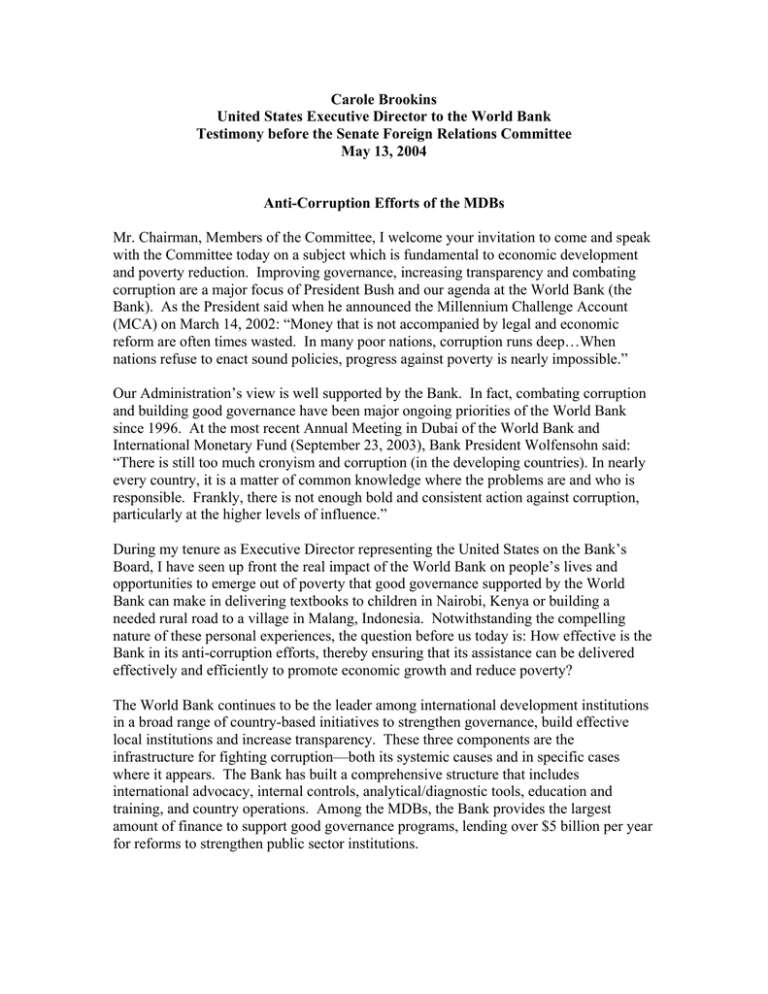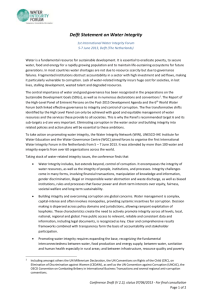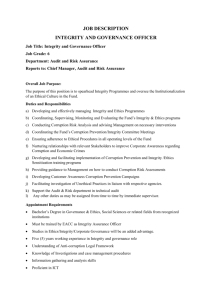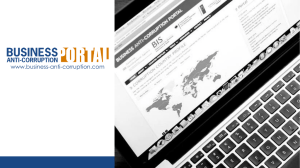Carole Brookins United States Executive Director to the World Bank
advertisement

Carole Brookins United States Executive Director to the World Bank Testimony before the Senate Foreign Relations Committee May 13, 2004 Anti-Corruption Efforts of the MDBs Mr. Chairman, Members of the Committee, I welcome your invitation to come and speak with the Committee today on a subject which is fundamental to economic development and poverty reduction. Improving governance, increasing transparency and combating corruption are a major focus of President Bush and our agenda at the World Bank (the Bank). As the President said when he announced the Millennium Challenge Account (MCA) on March 14, 2002: “Money that is not accompanied by legal and economic reform are often times wasted. In many poor nations, corruption runs deep…When nations refuse to enact sound policies, progress against poverty is nearly impossible.” Our Administration’s view is well supported by the Bank. In fact, combating corruption and building good governance have been major ongoing priorities of the World Bank since 1996. At the most recent Annual Meeting in Dubai of the World Bank and International Monetary Fund (September 23, 2003), Bank President Wolfensohn said: “There is still too much cronyism and corruption (in the developing countries). In nearly every country, it is a matter of common knowledge where the problems are and who is responsible. Frankly, there is not enough bold and consistent action against corruption, particularly at the higher levels of influence.” During my tenure as Executive Director representing the United States on the Bank’s Board, I have seen up front the real impact of the World Bank on people’s lives and opportunities to emerge out of poverty that good governance supported by the World Bank can make in delivering textbooks to children in Nairobi, Kenya or building a needed rural road to a village in Malang, Indonesia. Notwithstanding the compelling nature of these personal experiences, the question before us today is: How effective is the Bank in its anti-corruption efforts, thereby ensuring that its assistance can be delivered effectively and efficiently to promote economic growth and reduce poverty? The World Bank continues to be the leader among international development institutions in a broad range of country-based initiatives to strengthen governance, build effective local institutions and increase transparency. These three components are the infrastructure for fighting corruption—both its systemic causes and in specific cases where it appears. The Bank has built a comprehensive structure that includes international advocacy, internal controls, analytical/diagnostic tools, education and training, and country operations. Among the MDBs, the Bank provides the largest amount of finance to support good governance programs, lending over $5 billion per year for reforms to strengthen public sector institutions. The Bank’s anti-corruption infrastructure has performed effectively in many aspects and in managing many challenges. However, there is more that could be done to strengthen the system. Our Administration is directly pursuing ways to get the desired results both internally and on the ground in countries where the Bank operates. This Committee’s 2003 legislation, Section 581 of the FY2004 Consolidated Appropriations Act, which the Committee (working with Treasury) crafted, is an important tool for our efforts to enhance accountability and transparency. The Bank’s mandate is to end poverty in member countries by strengthening their investment climates in support of jobs and growth, and by creating local capacity to deliver services to the poor. In many cases, the Bank’s services are in great demand in countries where governance standards and institutional capacities are lacking. By the very nature of its mandate, the Bank needs to be involved in these countries to help improve their governance structures. The challenge is to establish procedures that successfully mitigate the risks posed by corruption and effectively deliver on the Bank’s mandate. The U.S. is fully committed to meeting this challenge. My office has an ambitious agenda with respect to anti-corruption and transparency efforts. It approaches this issue at three levels. At the institutional level, we focus on improving the functioning of the Bank’s internal control processes for preventing and responding to corruption and fraud. At the project level, we focus on encouraging the Bank to conduct analysis and design projects and lending policies that help to reduce opportunities for corruption and ensure that Bank funds will be well spent. At the country level, my office is a driving force to increase transparency and disclosure of Bank operations and anaylsis. Institutional Efforts As a major provider of development expertise and funding, the Bank recognizes that it must lead by example. Therefore, the World Bank has established systems to ensure institutional integrity, accountability and the rigorous investigation and resolution of cases involving fraud and corruption. In November 2000, the World Bank created the Department of Institutional Integrity (INT) out of two preexisting offices tasked with combating corruption. The INT has played an important role in investigating allegations of misconduct by firms, individuals, and Bank staff. INT also supports training for Bank staff to identify ways to detect and deter fraud and corruption in Bank operations. In order to be proactive, anti-fraud and corruption training is provided by INT to all new Bank operations staff as part of their introductory training. The Bank has a hotline (1-800-831-0463) where the public or staff can report incidents of corruption or other inappropriate practices. Whistleblower protection is ensured and complaints may be made annonomously or confidentially. The Bank has instituted several reforms that attempt to eliminate conflicts of interests and any possible corrupt practices among its staff. In 2003, the Bank announced the strengthening of its financial disclosure obligations for senior staff. All of the Bank’s 2 senior managers and Board members are now required to provide an annual statement listing their financial interests and those of their immediate families. The Bank’s Internal Auditing Department (IAD) guides World Bank management in establishing and maintaining strong internal controls and risk management procedures. IAD performs audits of the internal controls of business processes to assess their integrity, and provides advice on the design, implementation, and operation of internal control systems. In 1997, a special unit within IAD was created specifically to review all allegations and guard against fraud or corruption within the World Bank Group. This group works with an Oversight Committee Against Fraud and Corruption. The Bank has taken formal steps to review its internal controls. Beginning in 1995, the Bank adopted the internationally recognized internal control framework known as COSO (Committee on Sponsoring Organizations). More recently, as part of Bank management’s annual assessment of internal controls, management and the independent auditor provide letters regarding the adequacy of internal controls over external financial reporting. The two letters are published with the financial statements in the Bank’s annual report. In the area of accountability the World Bank has two key institutions, the Operations and Evaluation Department (OED) and its equivalents at the IFC and MIGA (OEG and OEU) and the Quality Assessment Group (QAG). Established in 1973, the Operations Evaluation Department (OED) is independent of management and reports directly to the Bank's Board of Executive Directors. OED evaluates the effectiveness of the Bank’s operations at the project, sector, and country level, and assesses its lasting contribution to a country’s overall development. Quality Assurance Group (QAG) was created in 1996 with the express purpose of improving the quality of Bank output within the broad context of alleviating poverty and achieving development impacts. QAG’s mandate is to increase management and staff accountability by conducting real-time assessments of the quality of the Bank’s portfolio under implementation as well as the quality of the initial formulation of projects and programs. A related unit, The Quality Assurance and Compliance Unit (QACU) was established in 2001 as part of the World Bank’s Environmentally and Socially Sustainable Development Vice Presidency. QACU ensures that safeguard policies are implemented consistently across the regions, and gives advice on compliance with the safeguard policies in projects. Safeguard coordinators, with dedicated funding, are appointed in each region to oversee project compliance with the policies and assure that the proper steps have been taken to avoid or mitigate negative impacts. Project-Level Efforts The World Bank utilizes a number of effective tools to mitigate the risk of corruption in designing projects, as well as mechanisms to address instances when it finds that corrupt practices have occurred in the course of project implementation. 3 First, the Bank has procurement and consultant guidelines that govern the purchase of goods, civil works and consulting services financed in whole or in part from Bank loans for investment projects. The guidelines emphasize the need for economy and efficiency in the implementation of the project, the importance of transparency in the procurement process, and state that open competition is the basis for efficient public procurement. The guidelines include anti-fraud and corruption provisions and provide for debarment or other remedies if the Bank determines that firms have engaged in corrupt or fraudulent practices. If World Bank procurement guidelines have not been followed, then the Bank could declare a misprocurement and the borrowing government will lose the relevant funding. Related to this, the Bank has actively enforced its administrative sanctions policy. Under this policy, the Bank debars firms and individuals from participating in any further Bank, or Bank-financed, projects if they are determined to have engaged in corrupt, fraudulent, collusive, or coercive practices in competing for, or in executing, a Bank contract. More than 180 companies and individuals have been debarred from doing business with the Bank, either temporarily or permanently. In addition, the World Bank refers matters to national justice officials for prosecution in cases when its internal compliance unit uncovers evidence that laws have been broken. The Bank makes the list of the debarred firms and individuals publicly available on its website. This illustrates the strong commitment the Bank has to eliminating corruption at the project-level, as well as the financial and reputational costs to the private sector of engaging in corrupt or noncompliant activities. In 1993, the World Bank created the Inspection Panel as an independent forum to private citizens who believe that they have been or could be directly harmed by a project financed by the World Bank. Twenty-seven formal requests have been received since Inspection Panel operations began in September 1994. Panel reports are publicly available on the Bank’s website. The IFC, the Bank’s private sector institution, and MIGA have a Compliance Advisor/Ombudsman whose role is three fold: (1) To advise and assist IFC/MIGA to address complaints by people directly impacted by projects in a manner that is fair, objective and constructive, (2) To oversee compliance audits of IFC/MIGA, overall environmental and social performance, and specific projects, and (3) To provide independent advice to the President and management on specific projects as well as broader environmental and social policies, guidelines, procedures and resources. The IFC has also been crucial in developing the Equator Principles that were adopted by ten leading banks from seven countries announced on June 4, 2003. The Equator Principles are a voluntary set of guidelines for managing social and environmental issues related to the financing of development projects that are based on the policies and guidelines of the World Bank and the IFC. Together, these banks represent approximately 70% of the project loan syndication market globally. In adopting the Equator Principles, a bank undertakes to provide loans only to those projects whose sponsors can demonstrate, to the satisfaction of the bank, their ability and willingness to comply with comprehensive processes aimed at ensuring that projects are developed in a socially responsible manner and according to sound environmental management practices. 4 However, more work is needed to address project-level concerns. Currently, the U.S. is pushing for the Bank to adopt a more systematic approach to measuring project results. This will facilitate a proactive examination early and regularly in the project life-cycle of whether Bank projects are meeting their objectives. Such examination can be a useful tool in identifying if corruption is playing a role. Anti- Corruption Efforts at the Country Level As mentioned above, the World Bank provides over $5 billion per year to help countries reform and strengthen governance measures that prevent and punish corruption. Numerous examples of these programs can be found in the annual report that the U.S. Treasury provides to Congress on anti-corruption actions taken by countries as a result of MDB assistance. They include programs that promote a wide range of judicial, fiscal, procurement and regulatory reform. The World Bank and other IFIs have intensified efforts to assist countries to improve the quality of public expenditures. The Bank has increased assessment of the content and overall efficiency of public expenditures with the help of Public Expenditure Reviews (PERs), Country Financial Accountability Assessments (CFAAs), and Country Procurement Assessment Reports (CPARs). Expenditure Tracking Assessments for Highly Indebted Poor Countries (HIPCs) have also been used to evaluate budget formulation, execution and reporting in twenty-four HIPCs over the last several years. My office is pushing hard to get the Bank to conduct PERs, CPARs, and CFAAs in all borrowing countries and follow up these assessments with technical assistance and projects that address the weaknesses identified. This is particularly necessary in countries that will be receiving adjustment lending funds or direct budget support. Another important Bank diagnostic is the Investment Climate Assessment (ICAs), which attempts to systematically analyze conditions for private investment and enterprise development in World Bank countries. These assessments examine the factors constraining market activity, in particular, the weaknesses in a country’s legal, regulatory, and institutional framework. As a result, ICAs are a useful tool in identifying those areas where country reforms could have the greatest impact in stimulating private sector activity and reducing official corruption. The World Bank has also been a leader in the research and analysis of corruption. Particularly notable is the work of the World Bank Institute (WBI) which has developed new approaches to measuring corruption and assessing its monetary and developmental impact. The World Bank has joined with some of the very civil society groups represented on one of today’s panels – Transparency International – to co-host an anticorruption workshop highlighting the challenges in overcoming vested interests against reform. Through this and similar conferences the Bank is creating a frank dialogue about the roots of corruption in the hope of building a stronger social consensus on values and ethics in borrowing member countries. 5 The Bank’s commitment to governance and fighting corruption is further illustrated by the way in which International Development Association (IDA) resources are allocated to the seventy-seven recipient countries, which include the world’s poorest nations. Governance is a major factor in the IDA performance-based allocation system, which the Bank utilizes on an annual basis to determine the amount of resources countries are eligible to receive. Consequently, countries that improve governance and efforts to combat corruption are rewarded with additional IDA resources, while those whose governance scores decline receive fewer resources. As a result, the Bank has had many requests from countries for advice and assistance in addressing issues that would improve their governance scores. Another key element in the battle against corruption is transparency, where the Bank has been at the forefront in terms of disclosure of documents and consultation with civil society. The Bank has frequently updated its information disclosure policy to establish and institute best practices among the MDBs. My office continues to work with the Board and Management to ensure that further transparency is achieved in the context of additional improvements to the Bank’s disclosure policy, consistent with legislation from Congress in the FY04 appropriations process as well as international commitments by the G-8 at last year’s summit in Evian, France. Conclusion: The Bank has made considerable progress in establishing the foundation required to address governance and corruption in its operations and in the countries where it works. The Bank also has the leadership of senior management at the forefront on this critical issue. We cannot afford complacency however; continued effort and vigilance are required, both institutionally and in countries receiving assistance. Among the challenges going forward will be to achieve greater coherence across international institutions on issues like debarment, procurement and consultant guidelines, fiduciary standards and transparency. Most important to building a sustainable anti-corruption culture is building ownership in borrowing countries. The goal must be to increase their demand for good governance, so that they are accountable to their own citizens, who will then be better able to benefit directly from their own country’s development. Mr. Chairman, the U.S. is committed to the full scope of this effort and we will continue to exercise our leadership and influence in this vital cause. 6





